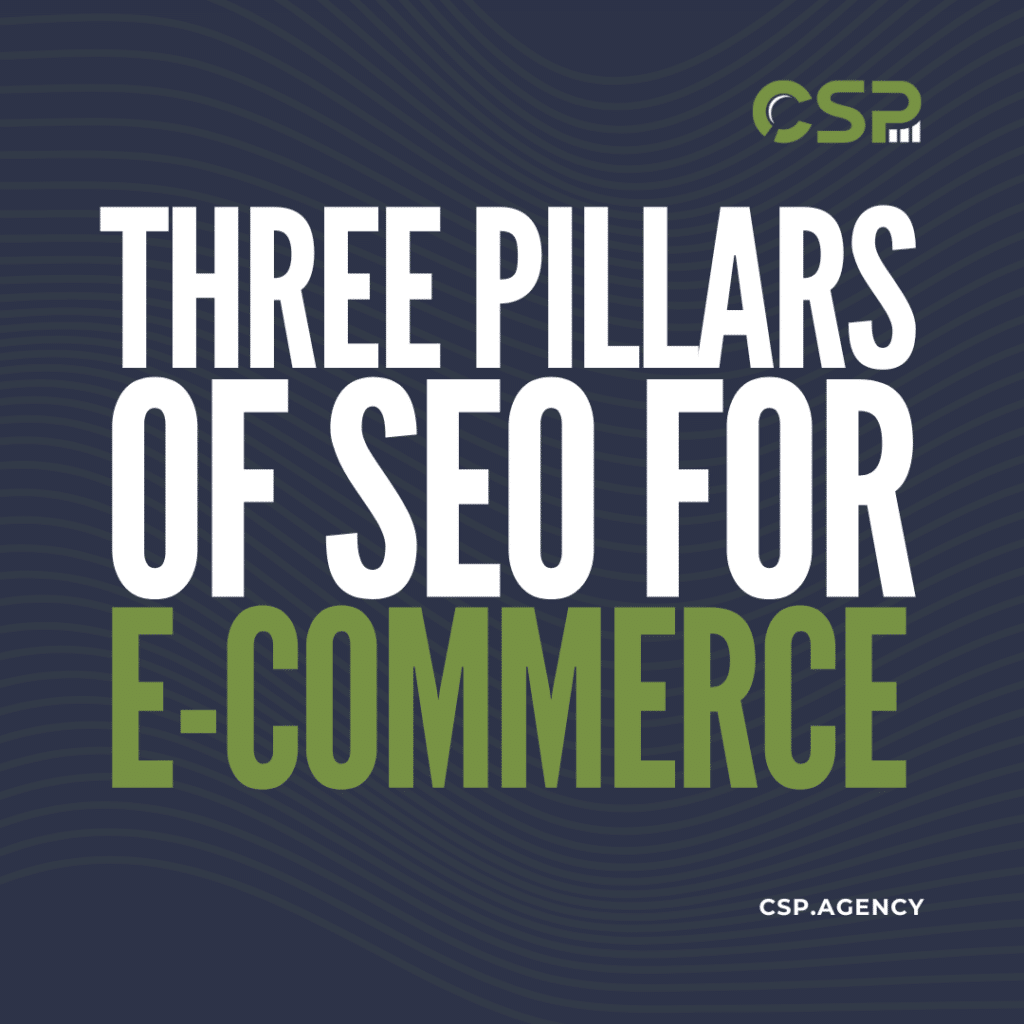Accessibility, Relevancy, Reach – The Pillars of E-commerce SEO
Creating a successful e-Commerce store requires more than a great idea and product. With its competitive landscape, navigating saturated search results, conversions, and backlink value can feel complicated and overwhelming. That’s where Search Engine Optimization, or SEO, can help. To truly move the needle with your e-Commerce store within top search engines, focusing on the three pillars of SEO is essential, as it provides a solid foundation for your website.
The three pillars of SEO include Accessibility, Relevance, and Reach. To understand these more thoroughly, we’ve created this article to provide tips for e-Commerce SEO that will help you take your online store to the next level.
What Are the Three Pillars of SEO?
1. Accessibility (Technical SEO)
Accessibility, or technical SEO, involves the specific structural elements, tags, and formatting required to ensure your website functions properly. Technical SEO is not only useful for formatting purposes but can prevent major errors and slow loading times. When it comes to e-Commerce storefronts with thousands of potential product pages and SKUs, loading time and accessibility are crucial.
The Importance of Technical SEO
One of the most important tips for e-Commerce SEO to keep in mind is the importance of technical SEO. Here’s why technical e-Commerce SEO matters:
- Indexing: If your e-Commerce store is not formatted properly, search engines will not have the ability to index or crawl your pages. This can ultimately prevent your website from appearing in any search engine results.
- Scalability: Scalability is essential with each e-Commerce template you create using meta tags, headers (H1, H2, H3 tags), and more. Anchor text, image descriptions, and alternative text all play a role within search engines as well. Use formatted templates that can be easily edited, updated, and used to promote specific products, content, or SKUs.
- User Experience: Websites that load slowly have a significantly higher bounce rate. Broken links can also cause a loss of trust or credibility among users. This is why regularly reviewing technical SEO is imperative.
Tips to Keep in Mind for Technical SEO
- With technical SEO, it’s important to organize your website based on categories, subcategories, and even product types. Creating a virtual sitemap of your planned e-Commerce storefront is a way to logically organize your site for both visitors and search engines.
- Test e-commerce pages and templates before using them at scale. This will prevent errors that can cause significant breaks in your storefront, leading to a loss of sales and/or conversions.
- Monitor and catch potential errors in your formatting, so the fixes can be implemented across all templates. Using the same template with minor tweaks can help streamline the process of repairing broken links or changes to meta tags.
2. Relevance (On-Page SEO)
Your website’s voice, branding, content, metadata, and how effective your content is at addressing a user’s problem are essential. As LLMs (Large Language Models) and AI continue to rapidly advance, Google’s algorithms and metrics have also evolved. Google ultimately wants to ensure its users receive the content they want, whether they’re searching for a local restaurant or exploring an international investment.
As Google’s technologies expand, it’s important to keep up with what is working and what’s outdated, especially in terms of messaging, content, and scalability.
Why Relevance Matters to Your E-Commerce Store
- Customer-Centric: As Google’s technology evolves to “think” more like a human, content that is organized, easy to read, and accessible is more likely to see a boost in search engine rankings. When crafting content, avoid repetitive phrases. Use your brand’s voice to bring your pieces to life. Spend time getting to know more about your users by responding to comments and inquiries, as this can also boost your storefront’s SEO.
- Reviews and Testimonials: User-generated reviews provide unique content for your site (which can help with SEO), while also promoting a trustworthy and reliable brand.
- Scalability: Using properly formatted templates is a way to scale content without writing each page from scratch.
3. Reach (Off-Page SEO)
Off-page SEO is about establishing your brand’s visibility and authority, beyond your official website. This may include social media followers/engagement, backlinks, and alternative pages on well-known communities.
Why Reach Matters
- Establishing Authority: Sites that have a robust setup of backlinks, relevant content, and human-first SEO priorities are more likely to outperform competitors.
- Attribution: The more visible and accessible your brand feels online, the easier it is to establish trust and conversions.
- Quality/Quantity: Quality backlinks from popular and authoritative sites can outweigh a page littered with low-quality links.
Which Pillar of SEO Is the Most Important for E-commerce Sites?
All the three pillars of SEO are essential. However, without Accessibility (Technical SEO), you may find it next to impossible to garner any attention or viability online. While managing an e-Commerce store, hundreds, if not thousands, of product SKUs, pages, and site sections may be required.
Any small technical error that is not monitored and/or mitigated can cause your website to load slowly (increasing your website’s bounce rate) or break entirely. Websites that are not formatted properly with technical SEO, keywords (short and long-tail phrases), and links, can also lead to inefficient search engine crawls.
How Do You Write Scalable Content Without Being Dependent on AI?
Using AI is a great way to brainstorm ideas and even logically format content. However, as your eCommerce storefront grows, you’ll want to write scalable content without benign dependence on AI (which can lead to bland, boring, and uninspired descriptions). A few tips to keep in mind when developing your SEO foundation for both online and off-page reach include:
- Site Map: First, create a site map with the vision you have for your e-Commerce store. Categorize products, services, content, and page types you envision for your site. This can help with organization down the road.
- Use Templates: Create a structured template that allows room for unique copy. Templates can include formatting elements such as meta tags, headers, backlinks, and even disclaimer locations.
- User-Generated Content: User reviews/testimonials, Q&A or FAQ sections, and user-submitted content draws attention and builds credibility for your brand in an authentic way.
- Put Customer Experience First: Your customer’s experience should always come first. Use features, navigation, and descriptions that are clear and accessible.
- AI as an Assistant: Using AI can be useful, whether you’re outlining a project, editing your writing, or even checking for coding errors. It’s important not to over-rely on AI, as this can cause your website to fall in the rankings among other AI-generated sites.
Understanding the pillars of SEO (Accessibility, Relevance, and Reach), is essential while navigating the ever-evolving landscape of e-Commerce. With Accessibility providing sound navigation and formatting, Relevance providing human-centered content and customer-written reviews, and Reach improving your brand’s visibility and your user’s shopping experience, you can immensely enhance the overall shopping experience of your customers.
If you’re interested in crafting compelling, unique product descriptions, you want to fix existing technical glitches, or you need a brand-new SEO strategy, understanding the three pillars of SEO is the first step. With these tips for e-Commerce SEO, you can create a winning strategy that boosts your visibility while still allowing you to put your clients and customers first.
The experts at CSP are ready to help build a solid SEO strategy and take your site to the next level. Get started by contacting us today.


